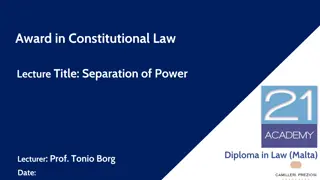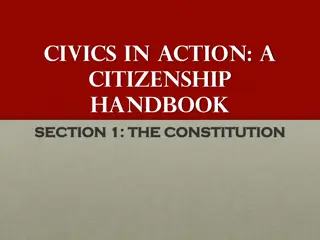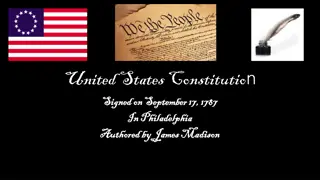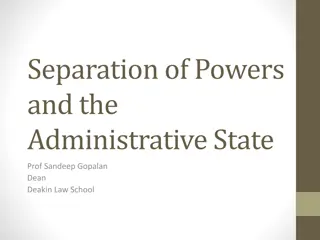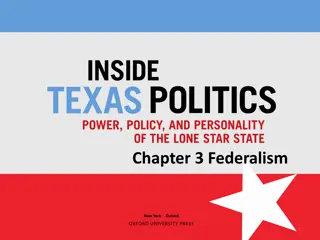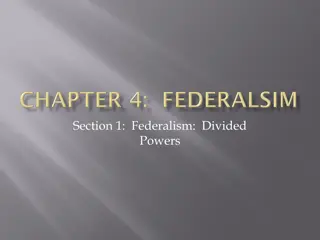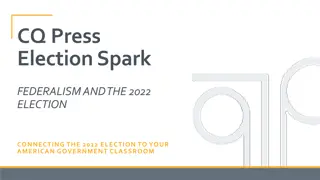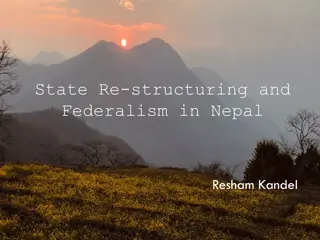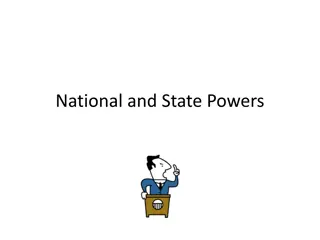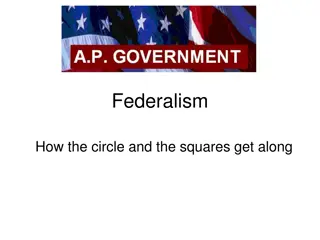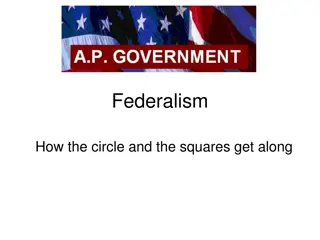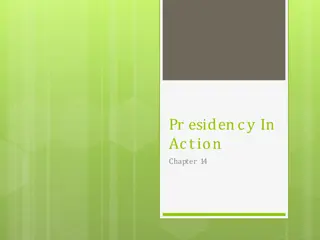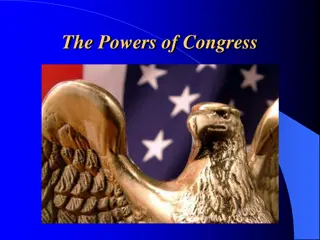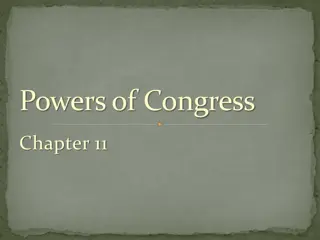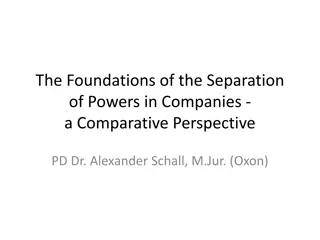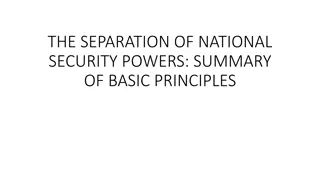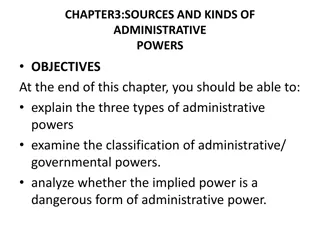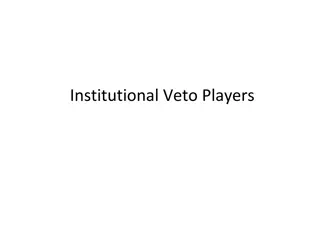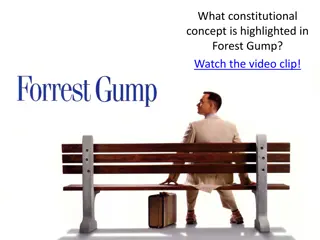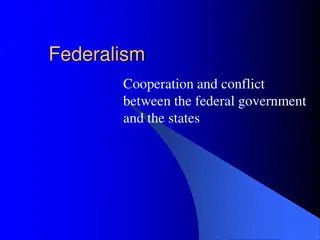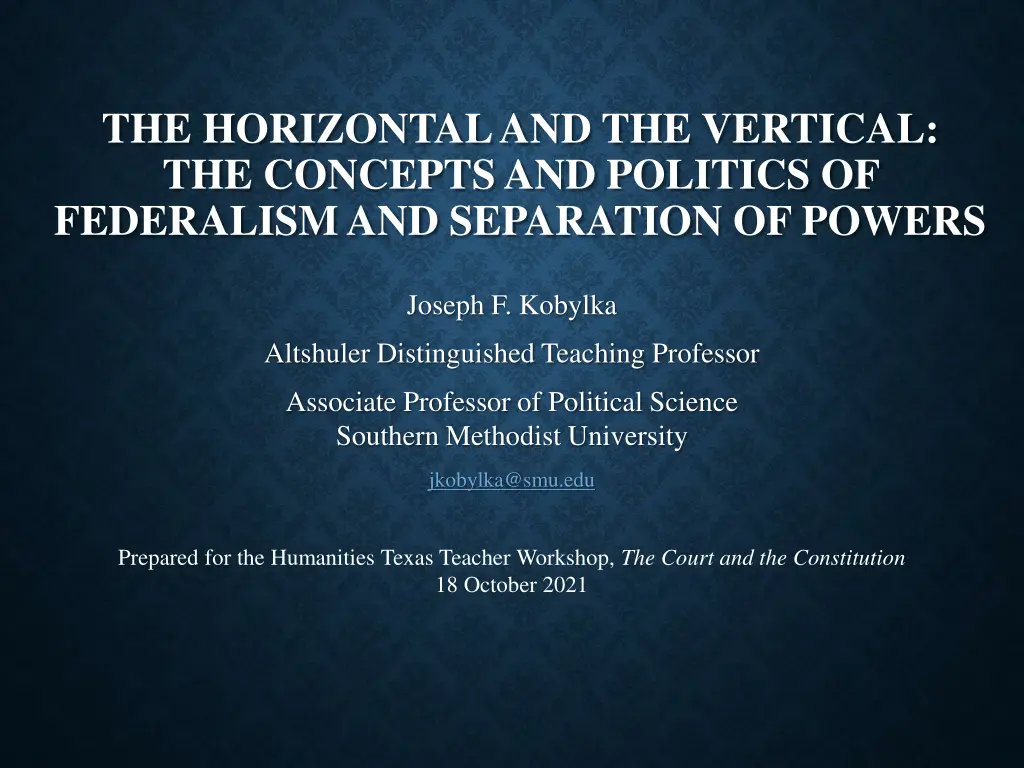
Federalism and Separation of Powers in Constitutional Development
Explore the concepts of federalism and separation of powers within the context of the Constitution's structural principles and political compromises. Delve into the historical significance and debates surrounding these foundational principles in American governance.
Download Presentation

Please find below an Image/Link to download the presentation.
The content on the website is provided AS IS for your information and personal use only. It may not be sold, licensed, or shared on other websites without obtaining consent from the author. If you encounter any issues during the download, it is possible that the publisher has removed the file from their server.
You are allowed to download the files provided on this website for personal or commercial use, subject to the condition that they are used lawfully. All files are the property of their respective owners.
The content on the website is provided AS IS for your information and personal use only. It may not be sold, licensed, or shared on other websites without obtaining consent from the author.
E N D
Presentation Transcript
THE HORIZONTAL AND THE VERTICAL: THE CONCEPTS AND POLITICS OF FEDERALISM AND SEPARATION OF POWERS Joseph F. Kobylka Altshuler Distinguished Teaching Professor Associate Professor of Political Science Southern Methodist University jkobylka@smu.edu Prepared for the Humanities Texas Teacher Workshop, The Court and the Constitution 18 October 2021
TWO MAJOR STRUCTURAL PRINCIPLES OF THE CONSTITUTION Federalist Nine, the Science of Politics Separation of Powers Legislative Ballances and Checks Life Tenured Judges Representation And Space Extent of Territory Federalism Today s Goal: Convey the Concepts in Layers and with a Story
THE CONTEXT OF CONVERSATION: HAMILTONIZE IT! Perhaps the time has come, to borrow Walton Hamilton s fine phrase, to raise the framers from immortality to mortality, to give them credit for their magnificent demonstration of the art of democratic politics. - John Roche, The Founding Fathers: A Reform Caucus in Action (1961) Play up the STORYand the DRAMA Hamiltonize It Put the Story back in History.
TWO MAJOR STRUCTURAL PRINCIPLES OF THE CONSTITUTION Separation of Powers Borne of English Constitutional Development Montesquieu s Reconstruction in The Spirit of the Laws General Colonial Practice and Consensus will discuss more fully in the following workshop Space Extent of Territory Federalism Borne of History: English Colonial Practice & Benign Neglect Politics: Compromises at the Constitutional Convention
POLITICAL COMPROMISE: VAGUENESS Article II of Articles of Confederation: Each state retains its sovereignty, freedom, and independence, and every Power, Jurisdiction, and right, which is not by this confederation expressly delegated to the United States, in Congress assembled. All at Constitutional Convention Wanted a Stronger National Government Basic Question: Goldielocksian Scope of Power Political/Constitutional Tension: States Rights (state sovereignty) Nationalism (popular sovereignty) No Consensus at Convention
TEXTUAL MANIFESTATIONS OF POLITICAL DISSENSUS The Enumerated Powers (Art. I 8, 1-17) The Congress shall have Power To make all Laws which shall be necessary and proper for carrying into Execution the foregoing Powers, and all other Powers vested by this Constitution in the Government of the United States, or in any Department or Officer thereof. (Art. I 8, 18) This Constitution, and the Laws of the United States which shall be made in Pursuance thereof; and all Treaties made, or which shall be made, under the Authority of the United States, shall be the supreme Law of the Land; and the Judges in every State shall be bound thereby, any Thing in the Constitution or Laws of any State to the Contrary notwithstanding. (Art. VI 2) The powers not delegated to the United States by the Constitution, nor prohibited by it to the States, are reserved to the States respectively, or to the people. (10th Amendment) Later: the no state shalls of the Fourteenth Amendment (1868)
RESULT OF DISSENSUS: CYCLES Typically referred to as States Rights vs. Nationalism Dual Federalism vs. Cooperative Federalism A Culinary Take: Layer vs. Marble Cake Same Constitutional Text(s), Different Interpretations Definition of Enumerated Powers of Art. I 8, 1-17 Definition of Necessary and Proper Clause of Art. I 8, 18 Definition of Tenth Amendment Impact of Supremacy Clause Art. VI, 2)
RESULT OF DISSENSUS: CYCLES OF FEDERALISM Federalist Cycle (1801 - 1835) Jackson/Taney Cycle (1835 - 1864) Civil War Cycle (1865 - 1873) Industrialism Cycle (1874 - 1936) New Deal Great Society Cycle (1937 - 1985) New Federalism Cycle (1986 - present)
FEDERALIST CYCLE John Marshall and the Dying Days of the Federalist Party Marbury v. Madison (1803) The Constitution is Law It is emphatically the province and duty of the judicial department to say what the law is. Constitutionalizes the Power of Judicial Review McCulloch v. Maryland (1819) Implied Powers Necessary and Proper Gibbons v. Odgen (1824) Commerce, undoubtedly, is traffic [buying and selling], but it is something more: it is intercourse.
JACKSON/TANEY CYCLE New York v. Miln (1837) Tenth Amendment All those powers which relate to merely municipal legislation or which may more properly be called internal police are not surrendered or restrained, and consequently in relation to these the authority of a state is complete, unqualified, and exclusive. Dred Scott v. Sanford (1857) Congress can exercise no power over the rights of persons or property of a citizen in the Territory which is prohibited by the Constitution. The Constitution of the United States recognises slaves as property, and pledges the Federal Government to protect it. And Congress cannot exercise any more authority over property of that description than it may constitutionally exercise over property of any other kind.
CIVIL WAR CYCLE Winners Write Laws (and History) Civil War Amendments Imposed New National Limits on States Thirteenth: No Involuntary Servitude Fourteenth: No state denial of privileges and immunities, life, liberty or property without due process of law, or equal protection of the laws. Fifteenth: No denial of vote based on race, color, or previous condition of servitude. Reconstruction: Grounded in Enforcement Clauses
INDUSTRIALISM CYCLE U.S. v. E.C. Knight (1895) Doubtless the power to control the manufacture of a given thing involves, in a certain sense, the control of its disposition, but this is a secondary, and not the primary, sense; and, although the exercise of that power may result in bringing the operation of commerce into play, it does not control it, and affects it only incidentally and indirectly. Commerce succeeds to manufacture, and is not a part of it. Hammer v. Dagenhart (1918) In interpreting the Constitution it must never be forgotten that the nation is made up of states to which are entrusted the powers of local government. And to them and to the people the powers not expressly delegated to the national government are reserved. Schechter Polutry v. U.S. (1935) The distinction between intrastate acts that directly affect interstate commerce, and therefore are subject to federal regulation, and those that affect it only indirectly, and therefore remain subject to the power of the States exclusively, is clear in principle. Carter v. Carter Coal (1936) Production and manufacture of commodities are not commerce, even when done with intent to sell or transport the commodities out of the State.
INDUSTRIALISM CYCLE: The Four Horsemen of the Apocalypse
INDUSTRIALISM CYCLE: The FDR/Democratic Effect
NEW DEAL & GREAT SOCIETY CYCLE U.S. v. Jones and Laughlin Steel (1937) Although activities may be intrastate in character when separately considered, if they have such a close and substantial relation to interstate commerce that their control is essential or appropriate to protect that commerce from burdens and obstructions, Congress cannot be denied the power to exercise that control. U.S. v. Darby (1941) Our conclusion is unaffected by the Tenth Amendment . The amendment states but a truism that all is retained which has not been surrendered. There is nothing in the history of its adoption to suggest that it was more than declaratory of the relationship between the national and state governments . (Overrules Hammer v. Dagenhart) Wickard v. Fillburn (1942) Even if appellee's activity be local and though it may not be regarded as commerce, it may still, whatever its nature, be reached by Congress if it exerts a substantial economic effect on interstate commerce and this irrespective of whether such effect is what might at some earlier time have been defined as 'direct' or 'indirect.' Heart of Atlanta Motel v. U.S. (1964) The determinative test of the exercise of power by the Congress under the Commerce Clause is simply whether the activity sought to be regulated is commerce which concerns more States than one and has a real and substantial relation to the national interest.
NEW FEDERALISM CYCLE: National League of Cities v. Usery (1976) 5-4, Nixon Appointees San Antonio v. Garcia (1985) 5-4, overturn NLC, Blackmun switch U.S. v. Lopez (1995) 5-4, first limitation on Commerce Power since 1936 Congress' commerce authority includes the power to regulate those activities having a substantial relation to interstate commerce, i.e., those activities that substantially affect interstate commerce Reagan/Bush appointees National Federation of Independent Businesses v. Sebelius (2012) 5-4, limit Commerce Power, uphold on Taxing Power The language of the Constitution reflects the natural understanding that the power to regulate assumes there is already something to be regulated . The Framers gave Congress the power to regulate commerce, not to compel it, and for over 200 years both our decisions and Congress's actions have reflected this understanding. Reagan/Bush/Bush appointees
SUMMARY AND DISCUSSION Federalism a Feature of American Constitutionalism from the Beginning Cycles in Definition a Function of Compromises at the Constitutional Convention Changing Perceived Policy Needs Shifting Justices on the Supreme Court Reinhold Niebuhr: Proximate solutions to insoluble problems. (Children of Light, Children of Darkness)
STAAR GRADE 8 SOCIAL STUDIES ASSESSMENT: SLO STAAR Grade 8 Social Studies Assessment: (4) History. The student understands significant political and economic issues of the revolutionary era. The student is expected to (D) analyze the issues of the Constitutional Convention of 1787, including the Great Compromise and the Three-Fifths Compromise; Supporting Standard (5) History. The student understands the challenges confronted by the government and its leaders in the early years of the republic and the Age of Jackson. The student is expected to (A) describe major domestic problems faced by the leaders of the new republic such as maintaining national security, building a military, creating a stable economic system, setting up the court system, and defining the authority of the central government;. Readiness Standard (F) explain the impact of the election of Andrew Jackson, including expanded suffrage; and Supporting Standard (15) Government. The student understands the American beliefs and principles reflected in the Declaration of Independence, the U.S. Constitution, and other important historic documents. The student is expected to (D) analyze how the U.S. Constitution reflects the principles of limited government, republicanism, checks and balances, federalism, separation of powers, popular sovereignty, and individual rights. (16) Government. The student understands the process of changing the U.S. Constitution and the impact of amendments on American society. The student is expected to (B) describe the impact of 19th-century amendments, including the 13th, 14th, and 15th amendments, on life in the United States. Readiness Standard (18) Government. The student understands the impact of landmark Supreme Court cases. The student is expected to (A) identify the origin of judicial review and analyze examples of congressional and presidential responses; Readiness Standard (B) summarize the issues, decisions, and significance of landmark Supreme Court cases, including Marbury v. Madison, McCulloch v. Maryland, and Gibbons v. Ogden; and Supporting Standard (C) evaluate the impact of selected landmark Supreme Court decisions, including Dred Scott v. Sandford, on life in the United States.
STAAR U.S. HISTORY ASSESSMENT: SLO (9) History. The student understands the impact of the American civil rights movement. The student is expected to (F) describe presidential actions and congressional votes to address minority rights in the United States, including desegregation of the armed forces, the Civil Rights acts of 1957 and 1964, and the Voting Rights Act of 1965; Readiness Standard (19) Government. The student understands changes over time in the role of government. The student is expected to (A) evaluate the impact of New Deal legislation on the historical roles of state and federal government; Readiness Standard (20) Government. The student understands the changing relationships among the three branches of the federal government. The student is expected to (B) evaluate the impact of relationships among the legislative, executive, and judicial branches of government, including Franklin D. Roosevelt s attempt to increase the number of U.S. Supreme Court justices and the presidential election of 2000. Readiness Standard
U.S. GOVERNMENT STANDARDS (113.44) (c) Knowledge and skills: (1) History. The student understands how constitutional government, as developed in America and expressed in the U.S. Constitution, [have] been influenced by ideas, people, and historical documents. (D) Identify the contributions of the political philosophies of the Founding Fathers, including Alexander Hamilton, Thomas Jefferson, James Madison . (F) identify significant individuals in the field of government and politics, including Thomas Jefferson, John Marshall (7) Government. The student understands the American beliefs and principles reflected in the U.S. Constitution . (A) explain the importance of a written constitution; (D) evaluate constitutional provisions for limiting the role of government, including republicanism, checks and balances, federalism, separation of powers, popular sovereignty, and individual rights; (E) describe the constitutionally prescribed procedures by which the U.S. Constitution can be changed (8) Government. The student understands the structure and functions of the government created by the U.S. Constitution. (B) analyze the structure and functions of the executive branch of government, including the constitutional powers of the president, the growth of presidential power, and the role of the Cabinet and executive departments; (C) analyze the structure and functions of the judicial branch of government, including the federal court system, types of jurisdiction, and judicial review; (E) explain how certain provisions of the U.S. Constitution provide for checks and balances among the three branches of government; (F) analyze selected issues raised by judicial activism and judicial restraint; (9) Government. The student understands the concept of federalism. (A) explain why the Founding Fathers created a distinctly new form of federalism and adopted a federal system of government instead of a unitary system; (B) categorize government powers as national, state, or shared; (C) analyze historical and contemporary conflicts over the respective roles of national and state governments; and (D) understand the limits on the national and state governments in the U.S. federal system of government.
SEEMINGLY RECURRING AP ITEMS Federalism Separation of Powers Commerce Clause Enumerated Powers in Foreign Affairs Tenth Amendment Judicial Review and Checks and Balances Supremacy Clause Fourteenth Amendment General Fifteenth Amendment Political Influences on Courts U.S. v. Lopez (1995) Judicial Independence
The Horizontal and the Vertical: The Concepts and Politics of Separation of Powers and Federalism Related Resources (the resources in red will be discussed in the Teaching the Document seminars) The Constitution: https://www.archives.gov/founding-docs/constitution-transcript Article I - http://avalon.law.yale.edu/18th_century/art1.asp Article II - http://avalon.law.yale.edu/18th_century/art2.asp Article III - http://avalon.law.yale.edu/18th_century/art3.asp Article VI - http://avalon.law.yale.edu/18th_century/art6.asp Tenth Amendment - http://avalon.law.yale.edu/18th_century/rights1.asp#10 Fourteenth Amendment - http://avalon.law.yale.edu/18th_century/amend1.asp#14 Federalism: McCulloch v. Maryland (1819) -http://law2.umkc.edu/faculty/projects/ftrials/conlaw/mcculloch.html Gibbons v. Ogden (1824) -http://law2.umkc.edu/faculty/projects/ftrials/conlaw/gibbons.html Dred Scot v. Sanford (1857) -http://law2.umkc.edu/faculty/projects/ftrials/conlaw/ScottvSandford.html Hammer v. Dagenhart (1918) -http://law2.umkc.edu/faculty/projects/ftrials/conlaw/hammer.html NLRB v. Jones & Laughlin Steel (1937) -http://law2.umkc.edu/faculty/projects/ftrials/conlaw/jonesnlrb.html U.S. v. Darby (1941) -http://law2.umkc.edu/faculty/projects/ftrials/conlaw/darby.html Heart of Atlanta Motel v. U.S. (1964) -http://law2.umkc.edu/faculty/projects/ftrials/conlaw/heartofatlanta.html U.S. v. Lopez (1995) -http://law2.umkc.edu/faculty/projects/ftrials/conlaw/lopez.html N.F.I.B.v. Sebilius (2012) -http://law2.umkc.edu/faculty/projects/ftrials/conlaw/NationalFederationvSebeliuscommer ce.html Separation of Powers: Marbury v. Madison (1803) -http://law2.umkc.edu/faculty/projects/ftrials/conlaw/marbury.html Ex Parte McCardle (1872) -http://law2.umkc.edu/faculty/projects/ftrials/conlaw/mccardle.html U.S. v. Curtiss-Wright (1936) -https://supreme.justia.com/cases/federal/us/299/304/ Youngstown Sheet & Tube v. Sawyer (1952) - http://law2.umkc.edu/faculty/projects/ftrials/conlaw/youngstown.html U.S. v. Nixon (1974) -http://law2.umkc.edu/faculty/projects/ftrials/conlaw/usvnixon.html Clinton v. Jones (1997) - http://law2.umkc.edu/faculty/projects/ftrials/conlaw/clintonvjones.html
The Horizontal and the Vertical: The concepts and Politics of Federalism and Separation of Powers QUESTIONS & COMMENTS jkobylka@smu.edu

